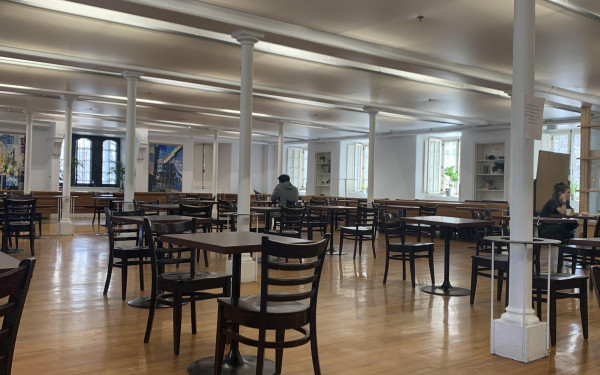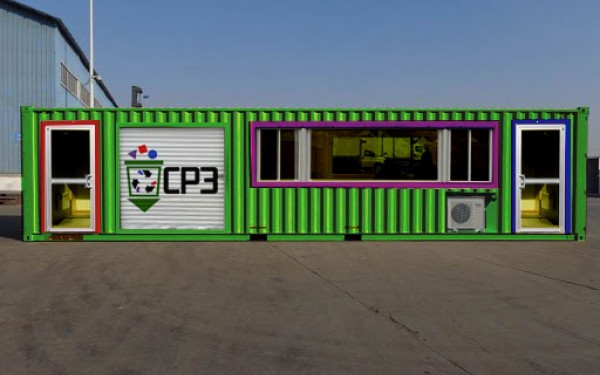Worshipping God, the Body and Booze
The Repurposing of Montreal’s Religious Spaces
It’s no secret that the city of Montreal is rich in history and culture. There are 59 National Historic sites in Montreal, many of which are religious or spiritual spaces. Due to economic issues, many of these religious spaces are forced to close their doors. The repurposing of these such buildings has proved to be a more sustainable and beneficial option than simply demolishing the buildings entirely.
Concordia’s very own Grey Nuns Residence
Concordia’s newest student residence has spacious, bright rooms, a breath-taking study hall and a central location in downtown Montreal. It also has something no other university in Canada has: a crypt in the basement, containing the remains of nuns who lived and died in the former Grey Nuns Motherhouse.
The Grey Nuns residence is located at 1185 rue St. Mathieu. The land itself was bought by the Grey Nuns, also known as the “Sisters of Charity of Montreal,” in 1861, which is now considered the land between streets Ste. Catherine, Guy, St. Mathieu and René-Lévesque.
The residence was built by Québécois architect Victor Bouregau in 1871. Bourgeau was renowned for his work with limestone and famous for designing other buildings in Montreal such as the Montreal General Hospital. The chapel of the Grey Nuns was officially built in 1879, and the complex continued to grow throughout the years until 1901, when the orphanage and Motherhouse were added.
The Grey Nuns, led by St. Marguerite D’Youville, dedicated their lives to helping others in their community. For many years the Grey Nuns building served as a temporary home to people in need such as orphans, individuals struggling with poverty and soldiers during the first and second world wars.
Marguerite D’Youville passed away in 1771 and her remains were later kept in the chapel of the Grey Nuns building. However, her remains were relocated in 2011. The remaining nuns also planned to relocate the remains from the crypt in the basement, but were unable to do so due to health reasons, as many of the nuns had passed away from typhoid.
Concordia officially acquired the Grey Nuns building in 2007, which came as a great surprise to the community since the university had been attempting to purchase the building since 1975. In 2011, Concordia had full proprietorship of Grey Nuns and use of the chapel and main wing of the building. The few remaining Sisters of Charity planned to stay in the building until 2022, but later decided to leave early before the start of the 2014/2015 school year.
Today, the Grey Nuns building is home to roughly 600 Concordia students. Over the past year, the building has undergone a great deal of construction on the east wing of the building and now has a large cafeteria in the basement.
In 1974 the chapel in the Grey Nuns building was named an official historical building under Canadian law and therefore cannot be removed by Concordia (the entire building received the same designation in 1976). The interior of the chapel has not been altered, but is now being used as a study hall at the heart of the Grey Nuns building.
Desiree Pollak-Garcia, a former Concordia student and Grey Nuns resident, has fond memories of living in the historical space.
“As a little girl I had always dreamt of living in a castle. It sounds cheesy, but living in Grey Nuns was sort of like that,” she said. “It was unlike any typical college experience. It’s incredible that the building is continuing to be of use to the city.”
It may seem ironic that what was once a home for hundreds of nuns is now a home to hundreds of beer-guzzling college students, but the history of the Grey Nuns and their eagerness to give back to the community is still very much alive.
“As a little girl I had always dreamt of living in a castle. It sounds cheesy, but living in Grey Nuns was sort of like that.” — Desiree Pollak-Garcia, former Concordia student and Grey Nuns resident.
St. Jude Spa & Gym
The St. Jude spa and wellness centre stands on a busy stretch of St. Denis St. in the heart of Montreal’s Plateau neighbourhood. It is housed in the decommissioned Dominican church and sanctuary to Our Lady of the Rosary and to St. Jude. The building, made of stone, brick and steel, was built in 1905 to provide for the religious needs of Montreal’s Irish community.
In 1953, the parish was transferred to the Dominican Friars, who altered the interior of the church slightly in 1954, giving it a more modern look. The building was later subject to even more alterations in accordance with the Vatican’s guidelines for alteration in the modern world. In 2007, the building was sold and construction on the building commenced.
3_900_601_90.jpg)
Shannon Coulter is a Concordia student studying religious studies and urban planning. Last year, she participated in a seminar course which studied the repurposing of religious buildings in Montreal. Visiting the St. Jude Spa and Gym, was a highlight for Coulter.
“It was one of the most interesting buildings I visited during my studies,” said Coulter. The outside of the building was completely preserved, so you had no idea that it was a gym and not still a church.”
Designed by architect Thomas Balaban, the layout of the building promotes a community-based wellness experience. The stairs, corridors and communal spaces reach out from the lounge, with a focus towards the church’s existing windows. Glass partitions are used to link the different spaces of the St.
Jude together and allow for a bright and open space.
When the Dominicans first announced their intention to sell the St. Jude church in 2007, and when Concordia first purchased the Grey Nuns building in 2004, many local parishioners petitioned to prevent these sales.
Although many spiritual people do not always agree with the repurposing of religious buildings such as the Grey Nuns building and the St. Jude church, the cultural and societal benefits of such projects are extremely evident. As part of her studies, Coulter analyzed the positive aspects of repurposing old buildings.
“In a lot of instances, when churches are no longer being used, they are demolished because they’re so impossible to afford” said Coulter. “When religious spaces are repurposed, non-religious people in the community or those from other denominations can now benefit from the space as well.”
This article originally appeared in Volume 35, Issue 20, published February 10, 2015.

4_900_601_90.jpg)
_900_601_90.jpg)
2_900_601_90.jpg)
_600_832_s.png)




-4_600_375_90_s_c1.jpg)